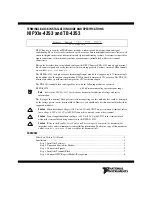
CURS100 100 Ohm Current Shunt Terminal Input Module
Datalogger
Transducer
I
H
L
G
+12 V
Signal
Power
FIGURE 4-1. 2-wire with datalogger power
Datalogger
Transducer
I
H
L
G
Signal
Power
Battery
–
+
FIGURE 4-2.
2-wire with external power
4.1.1 Possible Ground Loop Problems
The resistor must be grounded at the datalogger to ensure that measurements
are within common mode range. The signal (or low) output on the transducer
is higher than the datalogger ground by the voltage drop across the resistor. A
ground-loop error may occur if the signal output is not electrically isolated but
is connected to the sensor's case. If such a sensor is in contact with earth
ground (for example, a pressure transducer in a well or stream), an alternative
path for current flow is established through earth ground to the datalogger earth
ground. This path is in parallel with the path from the signal output through
the resistor; hence, not all the current will pass through the resistor and the
measured voltage will be too low.
4.1.2 Minimum Supply Voltage
When the power supply is in the current loop, as is the case in a 2-wire
transducer, it is necessary to consider the effect of voltage drop across the
resistor on the voltage applied to the transducer.
For example, suppose a 4 to 20 mA transducer requires at least 9 volts to
operate correctly and the system is powered by a 12 volt battery. The voltage
the transducer sees is the battery voltage minus the voltage drop in the rest of
the current loop. At 20 mA output, the voltage drop across the 100 ohm
resistor is 2 volts. When the battery is at 12 volts, this leaves 10 volts for the
5




































